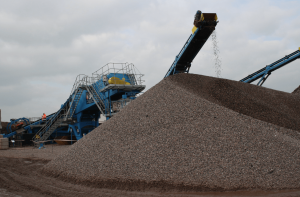
Recycled aggregate stockpile. Photo© CDE Global/Flickr.
Due to how it is sourced and produced, the mechanical properties and characteristics of Recycled Concrete Aggregate can vary greatly. As demand for this material grows, it is important for the construction industry to clearly understand the nature of RCA and how its applicability to different projects can vary based on its production and consequent mechanical properties. UTC partners at NJIT, in collaboration with NYC DOT, investigated this knowledge gap in a recent research project.
By 2027 the global recycled construction aggregates market is projected to pass 6.2 million tons as infrastructure systems age, natural aggregate sources and landfill space become limited, and the demand for environmentally and economically sustainable construction materials grows.
Recycled Concrete Aggregates (RCA) as a replacement in new concrete systems has gained popularity worldwide as a method for reducing natural aggregate consumption and meeting construction demands in a sustainable way. RCA is produced by mechanically crushing multiple waste concretes—such as the remains from construction and demolition projects—into aggregate-size pieces.
The buildup of structural debris following World War II launched initial research into using construction waste products as new, recycled material, said Dr. Matthew P. Adams, Associate Professor at the New Jersey Institute of Technology (NJIT) and Principal Investigator on this project. Since then, sustainable construction practices have become more common, a surplus of waste concrete has rapidly generated due to aging infrastructure and growing populations, access to natural aggregate in urban areas has decreased, and the environmental need to reduce landfilling of waste materials has been recognized.
“Interest in Recycled Concrete Aggregates has developed significantly over the past few decades,” he said. “However, research shows that the properties of recycled concrete can vary due to how it is sourced. More work still needs to be done to establish a consensus and industry best practices on applying and using this innovative material.”
To help accomplish this, NJIT researchers in collaboration with the New York City Department of Transportation (NYC DOT) developed a comprehensive database of RCA concrete mechanical properties based on selected experimental data and literature.
Using this database, researchers investigated potential applications of numerically generated RCA systems with different hardened properties including compressive strength, elastic modulus, splitting tensile strength, and flexural strength. A computer algorithm then analyzed the database and simulated concrete systems with different RCA replacement levels and more than 200 mechanical loading scenarios.
From this database and simulation modeling, researchers can make reliable predictions and provide guidance on RCA material variability that are representative of concrete systems being used today, Dr. Adams said.
For example, they found that RCA concrete can be made to meet the strength requirements of a range of construction projects, both structural and non-structural. Read the full report and findings here.

Dr. Matthew P. Adams, Associate Professor at NJIT and project Principal Investigator.
“This study serves as a supportive tool to develop, analyze, and interpret statistical data on RCA concrete mechanical properties,” he said. “Future use of this database can help develop design methodologies for making RCA concrete and improve risk assessments for agencies interested in using RCA. This work is a key step in moving research on RCA concrete into practice, and can support engineers and architects using this developing construction approach.”
The project also supports efforts at NYC DOT in managing their construction projects, demolished concrete, and RCA products.
“NJIT’s Designing Concrete Mixtures with RCA 2022 report will be very valuable to the NYC Department of Transportation as we seek to develop our own low carbon concrete mixtures,” said Kate Mikuliak, Program Manager for Strategic Policy at NYC DOT. “As a producer of RCA, better understanding the material variability is crucial in seeking beneficial reuse applications.”
“As our engineers seek to develop design methodologies for using RCA as a natural aggregate substitute in our concrete mixes, we will utilize this report as a guide,” she said. “We encourage NJIT to continue their research on the properties of RCA, including how strength can be improved by using supplementary cementitious materials and admixtures, which NYC DOT is also seeking low carbon design mixtures for.”
This study was conducted as part of the Center for Advanced Infrastructure and Transportation (CAIT) USDOT University Transportation Centers (UTC) research program.

